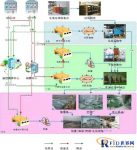
Internet of Things Urban Domestic Waste Treatment System Optimization Scheme
[ad_1]
Status of domestic waste treatment (take Shanghai as an example)
Domestic waste logistics has its own characteristics, and the total amount has changed significantly.
Due to its own characteristics: different regions, different cycles, and different disposal methods, the domestic waste logistics industry is also different from logistics in the usual sense.
Different regions
From the analysis of the annual live waste data of various districts and counties in Shanghai, there is a big gap in the output of domestic waste in various districts and counties. In 2007, the output of domestic waste in Pudong New Area was the highest, reaching 1.2 million tons, and Chongmin County, where the output was the smallest, was 95,000 tons. The former is 12 times as much as the latter.
Different periods
The amount of domestic waste generated is as large as every season and as small as every week, and the output is unevenly distributed.
The amount of domestic garbage produced varies from season to season, with the largest amount in summer from June to August, and relatively small amount in winter from November to February. There is a 30% difference between fewer months and more months. In view of the different changes in the amount of domestic waste, a matching logistics scheduling mode is required for processing.
Every week, the daily amount of household waste on weekends is more than the daily output from Tuesday to Wednesday.
The output of domestic waste is not balanced, and different scheduling and disposal measures are needed to match each other in different periods.
Different disposal methods
The disposal methods of domestic waste are divided into: landfill, incineration, biochemical treatment, simple landfill, etc. A variety of different disposal methods are provided by different transportation methods, so for different disposal methods, it is also necessary to be equipped with corresponding dispatching and disposal plans.
Informatization construction has achieved results, but the system is relatively scattered and lacks relevance.
At present, the Municipal Greening and City Appearance Bureau and various districts and counties have built information systems for the treatment of domestic waste, but there is no connection between the systems and the systems, they are relatively scattered, and are not within a unified framework system. Each system only focuses on a certain link in the domestic waste logistics, or a certain area, and does not manage the entire city’s domestic waste disposal process.
Related logistics data has been collected, but it is not fully covered, and the data cannot be reflected in real time.
Logistics-related data include weight, route, etc. Since the transportation path of domestic waste is relatively fixed, the weighing data of domestic waste is an important data that needs to be mastered in the management of domestic waste logistics. At present, 36 metering points have been installed in the city, of which 21 metering points have been installed for the municipal household waste weighing system, and 15 metering points have been installed by districts and counties themselves. 36 metering points, including 13 disposal points, 8 wharves, and 15 transfer stations. The household waste weighing data is currently submitted every other day, not in real time.

Business process analysis and optimization plan
Existing business process
The existing business process includes three flows of information flow, capital flow and logistics. The entire business flow includes the Municipal Greening and City Appearance Bureau, the District Greening and City Appearance Bureau, the sanitation operation company, the weighing operation company, the transfer station operation company, and the disposal point.
New business processes to be implemented after the construction of the information system
After the construction of the information system, on the original basis, two key nodes, the settlement center and the monitoring and command center, will be added to change the business process of capital flow and logistics. The settlement center integrates the originally decentralized fund management and distributes it uniformly by the settlement center, thereby effectively improving the shortcomings of the previous capital flow process. The monitoring command center will uniformly schedule the disposal of domestic waste in the city, unify the originally dispersed resources through the monitoring command center, allocate and use rationally, and optimize the original business process.
operating system
The application system includes a command center and six functional modules: dynamic logistics balance management, transfer and disposal process management, scheduling model and dynamic cost analysis, statistical analysis and auxiliary decision-making, expense settlement management, and logistics transfer vehicle process monitoring.
For more information, please contact the hotline 15161566366/051085386491-609
Address: 6F, China Internet of Things Industry Research and Development Center (200 Linghu Avenue, Wuxi New District)
[ad_2]



